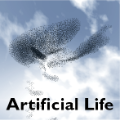Researching the conditions for the emergence of life -- not necessarily as it is, but as it could be -- is one of the main goals of Artificial Life. Answering this question requires a model that can first explain the emergence of evolvable units, namely, structures that (1) preserve themselves in time (2) self-reproduce and (3) can tolerate a certain amount of variation when reproducing. To tackle this challenge, here we introduce Combinatory Chemistry, an Algorithmic Artificial Chemistry based on a simple computational paradigm named Combinatory Logic. The dynamics of this system comprise very few rules, it is initialized with an elementary tabula rasa state, and features conservation laws replicating natural resource constraints. Our experiments show that a single run of this dynamical system discovers a wide range of emergent patterns with no external intervention. All these structures rely on acquiring basic constituents from the environment and decomposing them in a process that is remarkably similar to biological metabolisms. These patterns involve autopoietic structures that maintain their organisation, recursive ones that grow in linear chains or binary-branching trees, and most notably, patterns able to reproduce themselves, duplicating their number at each generation.
翻译:研究生命的出现条件 -- -- 不一定如此,但可能如此 -- -- 是人工生命的主要目标之一。回答这个问题需要一种模型,能够首先解释可变单位的出现,即:(1) 及时保存自己的结构(2) 自我生产,(3) 在再生时可以容忍一定数量的变异。为了应对这一挑战,我们在此引入混合化学,即基于一个简单计算模式(称为合并逻辑)的人工化学变异体。这个系统的动态由很少的规则组成,它以基本塔布拉 rasa 状态初始化,并具有可复制自然资源限制的保存法特征。我们的实验表明,这一动态系统的单一运行发现了广泛的突发模式,没有外部干预。所有这些结构都依赖于从环境中获取基本成分,并在一个与生物代代谢非常相似的进程中将其分解。这些模式涉及维持其组织的自制结构、在线链或双层树上生长的循环结构,以及最明显的是能够复制的形态。



